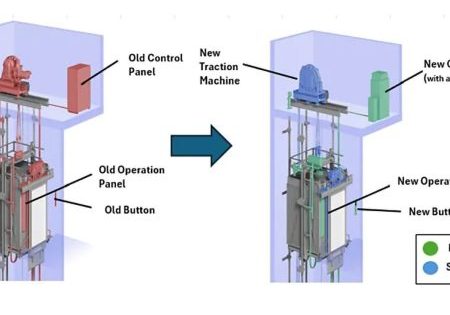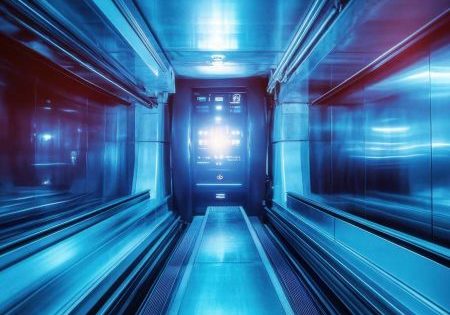Twenty-two myths uncovered by your author
by Zaydoon Khzouz
Elevators are one of the safest and most widely used forms of transportation globally, yet public misconceptions about their safety persist. These misconceptions, often fueled by media portrayals, anecdotal accounts and a lack of understanding of elevator mechanics, can lead to unnecessary anxiety and hazardous behaviors. As someone with more than 30 years of experience in the elevator industry, including 15 years in field operations, I have repeatedly encountered these doubts from users and even from well-educated individuals who are not specialists in elevators. Many perceive elevators as a highly dangerous mode of transportation, despite overwhelming evidence that they are significantly safer than other common transportation methods such as cars or trains (National Elevator Industry, Inc. [NEII], 2023).
This paper aims to address these misconceptions by debunking some of the most common myths about elevator safety. These myths have been identified through years of firsthand experience, visits to various websites, reviews of academic papers and interactions with users and professionals. While there are undoubtedly many other myths, this paper focuses on those that I, as a writer and industry professional, have found to be the most pervasive and impactful. By providing evidence-based clarifications supported by insights from leading elevator manufacturers (e.g., Otis, KONE, Schindler, Mitsubishi Electric) and international safety standards (e.g., ISO 8100, EN81-20/50, ASME A17.1/CSA B44), this paper seeks to enhance public understanding of elevator safety and promote evidence-based usage (KONE, 2022; Mitsubishi Electric, 2022).
Modern elevators are engineered with multiple layers of safety mechanisms, making them one of the safest modes of transportation.
Despite the advanced safety features and rigorous regulatory frameworks governing elevator systems, a significant gap exists between actual safety measures and public perception. Common myths, such as the belief that elevators are held by a single rope or that overcrowding can cause a fall, persist despite being scientifically unfounded (Deshpande, 2024). These misconceptions not only create unwarranted fear but also hinder the adoption of proper safety practices. By addressing these myths, this paper aims to foster public trust in elevator systems and highlight the critical role of technological advancements, regular maintenance and adherence to safety protocols in ensuring elevator reliability (Park & Yang, 2010; Rau et al., 2018).
Myths and Realities
1. MYTH: Elevators are held by only one rope that can break, leaving passengers trapped in a falling car.
REALITY: Elevators are supported by multiple steel cables or belts, each with a breaking strength far exceeding the total weight of the car and its maximum load. For example, a typical elevator system uses four to eight steel cables, each capable of supporting the entire weight of the car independently. This redundancy ensures that even if one cable were to fail, the remaining cables would safely hold the car in place. Additionally, elevators are equipped with overspeed governors and automatic brakes that activate in the rare event of a malfunction to prevent uncontrolled movement.
- Redundant Cables: According to EN 81-20/50 and ASME A17.1, elevator cables must have a safety factor of at least 12, meaning each cable can support 12 times the maximum load of the car. This ensures that the system remains safe even under extreme conditions.
- Overspeed Governors: These devices detect excessive speed and trigger the braking system to stop the car safely.
- Automatic Brakes: In the event of a cable failure, brakes engage to hold the car securely in place, preventing free-falling.
The dramatic scenes of elevators plunging and sparks flying, often depicted in movies, are purely fictional. Modern elevators are engineered with multiple layers of safety mechanisms, making them one of the safest modes of transportation. These systems are rigorously tested and regulated under EN 81-20/50 and ASME A17.1, ensuring passenger safety and reliability.
2. MYTH: An overcrowded elevator falls.
REALITY: Elevator falls are not caused by overcrowding, at least in up-to-date systems. Contemporary elevator systems have sensors that detect when a weight surpasses the maximum limit. In such instances, the elevator remains stationary with open doors, and an alarm signals passengers to lighten the load. Major manufacturers such as Otis, KONE and Schindler have incorporated this safety feature into their designs. (NEII, 2023)
Many people worry about exceeding the elevator weight capacity. This concern is understandable, as passengers are often squeezing into crowded elevators. However, what would happen if the weight limit were exceeded?
In most cases, there is no need for an alarm. Most modern elevators are designed with safety in mind and engineered to prevent uncontrolled descent. Even if passengers exceed the weight limit, the elevator will not plummet. Instead, overload sensors may be activated, preventing operation until the weight is reduced, or they may function at a limited capacity that strains the system.
This means that exceeding weight limits is less of a safety concern for passengers and more of an efficiency issue for those responsible for elevator operation and maintenance.
3. MYTH: Elevators can fall on several floors and “catch themselves.”
REALITY: The perception of an elevator “falling and catching itself” is a psychological phenomenon influenced by media portrayals and exaggerated accounts, often attributed to unexpected movements such as entering a car, traveling in the opposite direction of anticipation or observing rapid changes in floor indicators. Elevators are equipped with multiple safety mechanisms to prevent free-falling, including speed regulators, overspeed governors and automatic braking systems, as mandated by international standards such as EN 81-20/50 and ASME A17.1.
- Speed Regulators: These devices ensure the elevator operates within safe speed parameters.
- Overspeed Governors: In the event the elevator exceeds safe speed, the governor activates the braking system to halt the car.
- Automatic Brakes: In case of malfunction, brakes engage to secure the car in position.
These systems ensure smooth and safe operation, rendering the concept of an elevator “catching itself” after a fall implausible. The sensation is likely attributable to psychological factors, such as disorientation or anxiety, rather than actual movement. Elevators prioritize passenger safety, and their operation is strictly regulated by EN 81-20/50 and ASME A17.1 to ensure reliability.
4. MYTH: The hall doors open when the elevator is not present.
REALITY: Modern elevator hall doors are designed with interlocking mechanisms that prevent them from opening unless the elevator car is correctly aligned with the landing. This safety feature is mandated by international standards such as ISO 8100, EN 81-20/50 and ASME A17.1/CSA B44, ensuring that hall doors can only open when the car is present and properly positioned.
- Interlocking Mechanisms: These devices ensure that the hall doors remain locked unless the elevator car is at the landing, preventing accidental openings that could lead to falls or entrapment.
- Unlocking Devices: Elevator manufacturers must ensure that unlocking mechanisms engage only after the car has stopped and aligned with the landing, providing an additional layer of safety.
These features are critical for preventing accidents, particularly in high-rise buildings where misaligned doors could pose significant risks. By adhering to EN 81-20/50 and ASME A17.1, elevator systems ensure that hall doors operate safely and reliably, protecting passengers from potential hazards.
5. MYTH: If an elevator is stuck between floors, passengers are in danger of falling and should try to get out.
REALITY: Elevator cars are engineered as a “safe cabin” and are equipped with brakes and safety mechanisms that activate in the event of a malfunction, preventing the car from moving or falling. Attempting to exit on one’s own can result in serious injuries or fatalities, as passengers may fall down the shaft or become trapped between floors.
- Braking Systems: Elevators are equipped with automatic brakes that engage during malfunctions, holding the car securely in place.
- Emergency Communication: Passengers should use the emergency communication system (e.g., intercom or alarm button) to contact building management or emergency services.
- Professional Rescue: Trained rescue teams follow specific protocols to safely extract passengers, ensuring minimal risk during the process.
Both EN 81-20/50 and ASME A17.1 mandate these safety features, emphasizing that passengers should remain calm, use the emergency communication system and wait for professional assistance. Elevators are designed to prioritize passenger safety, and attempting to exit without professional help is highly dangerous and unnecessary.
6. MYTH: Pushing the CALL button repeatedly makes the elevator arrive faster.
REALITY: Multiple activations of the CALL button do not influence elevator velocity or arrival time. Elevator systems incorporate programmed logic that registers the initial call and prioritizes based on the controller’s algorithm. Repeated activation neither accelerates the car nor disrupts the programmed sequence, and manufacturers emphasize:
- Controller Logic: Elevator controllers utilize advanced algorithms to manage calls efficiently, ensuring that the car responds to requests in the most logical and safe manner.
- Safety and Efficiency: Repeated activation of the CALL button does not override the system’s prioritization logic, which is designed to balance efficiency and passenger safety.
These systems are regulated by EN 81-20/50 and ASME A17.1, which ensure that elevators operate reliably and respond to calls in a predictable manner. Passengers can be assured that a single activation of the CALL button is sufficient, as the system is designed to handle requests efficiently without superfluous input.
7. MYTH: Pushing the DOOR CLOSE button closes the doors faster.
REALITY: Activation of the DOOR CLOSE button initiates the door-closing sequence but does not accelerate the process. Elevator door operations adhere to safety regulations, such as EN 81-20/50 and ASME A17.1, which mandate specific speed controls and protective measures.
- Safety Features: Doors are equipped with sensors and mechanisms that detect obstructions or passengers, causing doors to decelerate, halt or reopen to prevent accidents.
- Force Limitations: Door closure occurs within prescribed energy thresholds to ensure safe operation.
The button signals the control system to commence closure after a predetermined interval, without overriding safety protocols. Manufacturers such as Otis emphasize that passenger protection takes precedence over rapid operation.
Consequently, the DOOR CLOSE button does not expedite door closure. Elevator doors are designed with safety as the primary consideration, adhering to EN 81-20/50 and ASME A17.1 standards to ensure secure and reliable performance.
8. MYTH: It is possible to escape through a safety hatch in an elevator.
REALITY: Safety escape hatches, or emergency access panels, are designed solely for trained emergency responders and cannot be accessed from within the elevator car. These hatches are regulated under international safety standards, including EN 81-20/50 and ASME A17.1, which specify requirements for their design, placement and use. Attempting to escape through these hatches or forcibly opening elevator doors is highly dangerous, as it can lead to severe injuries, falls down the elevator shaft or entrapment between floors.
EN 81-20/50 Requirements for Safety Escape Hatches
EN 81-20/50, Section 5.7.3 specifies that:
- Accessibility: Safety hatches must be located on the elevator car top and securely locked from inside to prevent unauthorized access by passengers.
- Design and Construction: The hatch must withstand mechanical stress, prevent accidental opening and have a secure locking mechanism openable only from outside by trained personnel using specialized tools.
- Emergency Use: The hatch is solely for trained rescue personnel during emergencies. Passengers must not attempt to use the hatch under any circumstances.
ASME A17.1 Requirements for Safety Escape Hatches
ASME A17.1, Section 2.14 specifies that:
- Locking Mechanisms: The hatch must have a locking device preventing it from being opened from inside the car.
- Structural Integrity: The hatch must withstand forces exerted during rescue operations, ensuring it remains secure and functional under stress.
- Emergency Access: The hatch must provide safe and reliable access for trained emergency responders, be clearly marked and easily accessible to rescue personnel, while remaining inaccessible to passengers.
Safety Mechanisms and Passenger Protocols
Contemporary elevators have multiple safety mechanisms to protect occupants during malfunctions, including:
- Automatic Braking Systems: Required by EN 81-20/50 and ASME A17.1, these engage during overspeed or power failure, preventing uncontrolled movement.
- Emergency Communication Devices: Both standards mandate intercoms or alarm buttons for passengers to communicate with building management or emergency services during a malfunction.
- Backup Power Systems: ASME A17.1 requires elevators to have backup power to safely reach the nearest landing and open doors during a power outage.
- During an elevator malfunction, remain calm, use the emergency communication device to contact building management or emergency services and wait for qualified professionals. Attempting to pry open doors or exit without professional assistance can cause severe injuries or fatalities, as individuals may fall down the shaft or become trapped between floors. Elevator shafts are hazardous environments with moving components that pose significant risks to untrained individuals.
Key Safety Protocols for Passengers
- Do Not Attempt to Use the Safety Hatch: Passengers must never open or exit through the safety hatch. This is strictly prohibited under EN 81-20/50 and ASME A17.1 and can lead to life-threatening situations.
- Use Emergency Communication Systems: Passengers should use the intercom or alarm button to notify building management or emergency services.
- Wait for Professional Assistance: Passengers should remain inside the elevator car and wait for trained rescue personnel.
Conclusion
Safety escape hatches are critical components of elevator safety systems but are exclusively for trained emergency responders. EN 81-20/50 and ASME A17.1 provide detailed requirements for the design, construction and use of these hatches to ensure passenger safety. Passengers must never attempt to use the hatch and should rely on emergency communication systems and professional rescue protocols established by these standards. By adhering to these guidelines, passengers can trust they are in a secure environment, even during unexpected incidents.
9. MYTH: Elevators are unsafe during power outages.
REALITY: Contemporary elevators incorporate backup power systems and emergency brakes that are engaged during electrical outages. Safety features, such as emergency illumination and communication systems, ensure that occupants remain secure until assistance arrives.
A frequent concern is the possibility of being trapped in an elevator without power. Although it is conceivable for an elevator to lose electricity while passengers are inside, such incidents are infrequent and typically resolved swiftly. The concept of elevator malfunction in this manner is essentially the creation of the entertainment industry. Although elevator stoppages are convenient plot devices for television characters, their prevalence in fiction does not reflect real-world occurrences.
In the event of power loss, occupants can use onboard alarms and intercom systems to notify responders. Passengers can communicate directly with personnel to receive updates and assistance until an issue is resolved. Modern elevators undergo regular maintenance and extensive safety inspections to prevent accidents. Elevator stoppages are uncommon and should not be a source of anxiety for riders.
10. MYTH: Elevators are unsafe in high-rise buildings.
REALITY: Advanced safety features are integral to high-rise elevators, incorporating seismic detection systems, fire-resistant components and backup braking mechanisms. Contrary to common misconceptions, elevators in tall buildings exhibit a higher degree of safety than generally perceived. Contemporary high-rise elevator systems employ multiple layers of safety measures to ensure passenger security and operational reliability. Seismic detection devices automatically cease operations when ground tremors are detected, thereby preventing potential accidents. The utilization of fire-resistant materials in elevator construction, such as fire-rated doors and enclosures, contributes to the containment of fire propagation during emergencies.
Modern elevators utilize multiple sensitive sensors that constitute a comprehensive anti-clamping system for cabin doors. These sensors are capable of detecting minor obstructions, promptly triggering the doors to reopen.
Furthermore, backup braking systems play a crucial role in high-rise elevator safety. These systems comprise several independent brakes that can be activated in the event of main brake failure, ensuring the safe halting of the elevator car during mechanical malfunctions. Additional safety features include backup power sources, automatic rescue mechanisms that transport elevators to the nearest floor during power outages and advanced monitoring systems that continuously evaluate performance and identify potential issues before they escalate in severity. These comprehensive safety protocols, in conjunction with routine maintenance and inspections, render modern high-rise elevators one of the most secure modes of transportation, with accident rates significantly lower than many commonplace activities.
11. MYTH: If stuck in an elevator long enough, you can run out of air.
REALITY: Elevator cabins are not completely sealed. Even with a malfunctioning ventilation system, air can circulate in and out, sufficient to prevent oxygen deprivation. The risk of suffocation in a stalled elevator is zero. Modern elevators have safety mechanisms including ventilation systems and spaces for air flow. During extended stoppages, passengers can be assured of adequate oxygen levels for a considerable amount of time.
12. MYTH: The safety of elevators for pregnant women is a matter of concern, and it is suggested that pregnant women should exercise caution when utilizing elevators because of the potential risks associated with sudden movements and jostling.
REALITY: There is no scientific evidence to support this assertion. Organizations such as the American Pregnancy Association delineate everyday activities to be avoided during pregnancy, primarily comprising high-impact exercises or strenuous lifting. The act of riding an elevator is not considered hazardous. Most elevators provide smooth, safe transit for all occupants, including pregnant individuals. In high-end structures, elevators are engineered for controlled operations and gradual movements, and standard usage presents no greater risk than stairs or escalators.
13. MYTH: Elevator doors can close on the users/passengers.
REALITY: There exists a misconception regarding the potential safety hazard posed by elevator doors to passengers. A prevalent belief suggests that placing one’s hands between closing doors is necessary to accommodate late arrivals — under the assumption that the elevator will not detect obstructions. However, this belief is unfounded, as contemporary elevators incorporate advanced safety features designed to prevent accidents and injuries.
Modern elevators utilize multiple sensitive sensors that constitute a comprehensive anti-clamping system for cabin doors. These sensors are capable of detecting minor obstructions, promptly triggering the doors to reopen. This technology effectively prevents entrapment or injury, ensuring passenger protection even during ingress or egress as doors are closing.
In conclusion, the belief that elevator doors present a significant risk to passengers is not substantiated by the advanced safety technologies implemented in modern elevators. The sophisticated anti-clamping systems and additional safety features create a secure environment for elevator users.
14. MYTH: Elevators are unsafe for children. Elevators are designed for safe use by adults; however, what concerns children?
REALITY: Authoritative organizations such as the American Academy of Pediatrics (AAP) and All the Industry Leaders assert that while elevators are not inherently hazardous, children — particularly those under 14 years of age — should be supervised when utilizing them. Elevators are engineered with numerous safety features to ensure passenger protection across all age groups. It is important to emphasize that most reported elevator incidents are linked to inadequate parental supervision rather than equipment failure. This highlights the critical need to educate parents on proper elevator usage and safety protocols for their children.
15. MYTH: Older buildings have elevators that are more likely to malfunction.
REALITY: Contrary to common perception, properly maintained elevators in older structures are not inherently more susceptible to malfunctions. The longevity and safety of an elevator system are determined by the quality and frequency of its maintenance, rather than the building’s age. Regular inspections, timely repairs and proactive maintenance ensure elevator reliability, irrespective of their installation date. Numerous older buildings have modernized their elevator systems with state-of-the-art technology to meet or exceed current safety standards.
These upgrades often include sophisticated control mechanisms, enhanced braking systems and advanced monitoring technologies, significantly improving performance and safety. Furthermore, many long-standing elevator systems benefit from years of operational data and refinements, contributing to their reliability when properly maintained. The foundation of elevator safety and efficiency in aging buildings lies in comprehensive maintenance, regular safety evaluations and ongoing modernization as technology and safety standards evolve.
Elevators in older buildings can maintain reliability and safety through consistent maintenance, safety inspections and modernization efforts. Many long-established elevator systems have been updated with contemporary features to comply with current safety regulations. The key to ensuring elevator reliability in older structures is thorough maintenance, as their performance depends more on upkeep than age. By implementing these measures, older elevators can maintain their dependability and safety, meeting the standards of newer systems.
16. MYTH: Elevators are vulnerable to hacking. With the integration of Internet-connected technologies in elevators, cybersecurity concerns have emerged. Can elevators be remotely compromised or manipulated?
REALITY: Although no digital system is entirely impervious to unauthorized access, cyberattacks on elevators are exceedingly uncommon. Organizations such as NEII lead the vertical-transportation (VT) industry. Manufacturers, including Otis, KONE, Schindler and Mitsubishi, have implemented sophisticated cybersecurity measures to mitigate potential risks. These measures encompass firewalls, encryption protocols, access control mechanisms and network segmentation, ensuring elevator systems maintain security within innovative building ecosystems.
Scientific Analysis of Elevator Cybersecurity
Contemporary elevators are integrated into Internet of Things-enabled networks using remote monitoring and predictive maintenance technologies. The industry employs multilayered security protocols:
- Encryption and Firewalls: Data transmission between elevator systems and control units is encrypted, preventing interception and unauthorized use. Firewalls restrict unauthorized access.
- Access Controls: Role-based access and multi-factor authentication limit system interaction with authorized personnel.
- Network Segmentation: Elevator systems are isolated from broader building networks, ensuring the compartmentalization of potential security breaches.
Risk Assessment and Mitigation
Penetration testing and research have identified theoretical vulnerabilities; however, real-world exploits are infrequent because of the following reasons:
- Proactive Security Updates: Manufacturers prioritize regular firmware updates to address emerging threats.
- Behavior-Based Monitoring: Real-time analysis detects and mitigates anomalous activities.
- End-to-End Encryption: For example, KONE and Mitsubishi Electric employ advanced encryption and key management systems to safeguard data integrity.
Conclusion
Integrating digital technologies into elevators introduces cybersecurity considerations; however, these risks are effectively managed through industry-wide standards and advanced security protocols. Elevator hacking remains a theoretical concern with minimal practical occurrence owing to the proactive efforts of manufacturers. Building owners should maintain vigilance by adhering to cybersecurity best practices and ensuring elevator systems’ continued safety and reliability in an interconnected environment.
17. MYTH: Glass elevators are less secure than conventional ones.
REALITY: The glass utilized in these elevators is typically reinforced and laminated to enhance durability and resist fracture. Each glass cabin incorporates safety features identical to traditional elevators, including emergency braking systems, door sensors and overload protection mechanisms. Regular inspections and maintenance ensure structural integrity and safe operation.
Glass elevators are often perceived as less secure due to their transparent nature; however, this is a misconception. The glass is specifically engineered to be highly durable and resistant to fracture. Manufacturers employ reinforced laminated glass, designed to withstand significant impact and pressure. This specialized glass often exhibits superior strength compared to materials used in conventional elevator cabins, providing equivalent or superior structural integrity.
Glass elevators are equipped with the same advanced safety systems as traditional elevators. These include emergency braking mechanisms that prevent free-fall, door sensors that detect obstructions and overload protection systems that ensure the elevator does not exceed its weight capacity. Glass elevators undergo rigorous and regular inspections and maintenance, analogous to conventional elevators. These routine examinations assess the structural integrity of the glass panels, the functionality of safety systems and overall elevator performance. This comprehensive approach ensures that glass elevators meet or exceed the same stringent safety standards applied to all elevator systems, effectively dispelling the notion of their perceived insecurity.
18. MYTH: Jumping to Safety: Another persistent myth suggests that jumping at the right moment during an elevator fall can prevent injury.
REALITY: This phenomenon is scientifically inaccurate and potentially hazardous to attempt. The forces experienced during a rapid descent render the precise timing of a jump nearly impossible and could result in injury. The notion of jumping to safety during an elevator fall lacks scientific foundation and poses significant risks. The forces present in a rapidly descending elevator make it exceedingly difficult to accurately time a jump. The velocity and acceleration of the falling elevator exceed an individual’s capacity to counteract them through jumping. Attempting such a maneuver in a confined, unstable environment could lead to serious injuries from collision with the elevator’s walls, ceiling or other occupants.
The principles of physics dictate that both the elevator and its occupants fall at the same rate, creating a relative state of free fall within the elevator car. Even if one could jump at the precise moment before impact, they would still be moving at the same velocity as the elevator upon ground contact. The sudden deceleration upon impact would likely result in severe injuries regardless of any attempted jump. Rather than relying on this misconception, it is crucial to understand that modern elevators are equipped with multiple safety features designed to prevent free falls and minimize the risk of accidents, rendering them one of the safest forms of transportation.
19. MYTH: Small elevators are less safe than large ones.
REALITY: There is no substantive reason for this point to be raised. Regardless of the size, an elevator that meets appropriate certifications and is correctly assembled and installed is significantly safer than an automobile on a typical road. It would be erroneous to assume that a smaller vehicle is inherently less safe than a larger one. The primary factors that compromise elevator safety, particularly in smaller units commonly installed in residential and low-rise buildings, are a disregard for safety features and regulations and inadequate maintenance practices.
20. MYTH: Elevators consume a significant amount of electricity throughout the day, including during inactivity.
REALITY: Contemporary elevator technology and materials have substantially enhanced the weight and durability characteristics compared to previous iterations. In recent years, the implementation of gearless motors and regenerative braking systems has significantly reduced energy consumption. This improvement is particularly advantageous in high-rise structures, where descending elevator cars frequently generate more electricity than they consume. Consequently, individuals can utilize elevators for VT between multiple floors without concerns regarding energy inefficiency.
21. MYTH: Elevator maintenance is unnecessary if the elevator operates without malfunction.
REALITY: While an elevator may appear to function properly, regular maintenance remains vital for ensuring passenger safety and operational efficiency and preventing unexpected breakdowns. Elevators are complex mechanical systems, and neglecting routine upkeep can lead to premature wear, thereby increasing the likelihood of failure.
Regular maintenance ensures consistent performance and extends critical components’ lifespan, reducing the need for costly repairs or replacements. Proactive upkeep provides long-term financial benefits, preventing expensive emergency repairs and downtime. Leading industry guidelines from manufacturers such as Otis, KONE, Schindler and Mitsubishi Electric emphasize the importance of adhering to strict maintenance schedules for safety and reliability.
Elevator maintenance is essential for immediate operational safety, efficiency and long-term cost savings. Neglecting to perform regular maintenance risks compromising system performance increases operational costs over time.
22. MYTH: Elevator accidents are rather common.
REALITY: Elevator accidents are infrequent, particularly compared to road or rail transportation incidents. Contemporary elevators are engineered with multiple redundant safety systems and operate under stringent international safety standards, such as ISO 8100, EN81-20/50 and ASME A17.1/CSA B44. These systems prevent fatal accidents even in the event of improbable mechanical failure.
Statistical data consistently demonstrates that elevators are among the safest modes of transportation. According to NEII, elevators in the U.S. facilitate 18 billion passenger trips annually with minimal accidents. Fatalities are rare and typically occur because of improper maintenance, misuse or during repair activities, not standard passenger operation.
- Key contributions to safety include the following:
- Regular Maintenance: Elevators adhering to scheduled inspections are highly improbable to malfunction. Compliance with the manufacturer and industry guidelines ensures optimal performance.
- Safety Features: Advanced engineering incorporates overspeed governors, emergency brakes, door interlocks and load sensors, which minimize risks.
- Stringent Regulations: Governmental and industry bodies enforce compliance with safety codes and standards.
While media reports of rare incidents may influence public perception, elevator systems are exceptionally reliable owing to technological advancements and robust safety protocols enforced by manufacturers such as Otis, Schindler, KONE and Mitsubishi Electric.
Road and rail accidents occur more frequently and often result in significant fatalities worldwide. When properly maintained, elevators have one of the lowest risk profiles for accidents, cementing their reputation as a safe and reliable VT mode.
Conclusion
The foundation of elevator safety is predicated on precise engineering, global standards and continuous innovations by industry leaders. However, public misconceptions regarding elevator safety persist, often perpetuated by media portrayals and a lack of familiarity with technology. As an industry professional with three decades of experience, including 15 years in field operations, this researcher has frequently encountered these misconceptions and the unwarranted apprehension they generate. This study has addressed some of the most prevalent misbeliefs, drawing upon evidence from industry leaders, scientific studies and extensive empirical experience (KONE, 2022; Mitsubishi Electric, 2022; NEII, 2023).
By elucidating these misconceptions, this paper aims to enhance public confidence in elevator systems and promote evidence-based utilization. In actuality, elevators are among the safest modes of transportation, incorporating sophisticated safety mechanisms and stringent regulatory frameworks that ensure their reliability (Park & Yang, 2010; Rau et al., 2018). Nevertheless, addressing misconceptions is crucial for fostering trust and promoting appropriate safety practices. The study also emphasizes the importance of routine maintenance, technological advancements and adherence to safety protocols in maintaining elevator safety (Zuo et al., 2024).
While this research focuses on the most prevalent misconceptions, it is noteworthy that numerous other misunderstandings could be explored in subsequent studies. The objective of this study is to provide a clear, evidence-based understanding of elevator safety and to demonstrate that elevators constitute a secure and dependable mode of VT.
References
1. ASME (2019). ASME A17.1/CSA B44: Safety Code for Elevators and Escalators. New York: American Society of Mechanical Engineers.
2. ISO (2020). EN 81-20/50: Safety Rules for the Construction and Installation of Lifts. Geneva: International Organization for Standardization.
3. Common Myths and Misconceptions About Elevators | Kings III. kingsiii.com/help-phone-blog/common-misconceptions-about-elevators/
4. Common Elevator Myths – Debunking Popular Misconceptions. elevatemonitoring.com/news-and-events/blog/debunking-common-myths-about-elevators/
5. Deshpande, O. (2024) Myths and misconceptions about elevators and safety: What is truly safe?, LinkedIn. Available at: linkedin.com/pulse/myths-misconceptions-elevators-safety-what-truly-onkar-deshpande-paxof
6. KONE (2022) Digitalization and Security in Vertical Transportation. Available at: kone.com
7. Mitsubishi Electric (2022) Safety and Security Standards for Connected Elevators. Available at: mitsubishielectric.com
8. National Elevator Industry, Inc. (NEII) (2023) Elevator Cybersecurity Guidelines. Available at: neii.org
9. Park, S.-T., & Yang, B.-S. (2010). An implementation of risk-based inspection for elevator maintenance. Journal of Mechanical Science and Technology, 24(12), 2367–2376. doi.org/10.1007/s12206-010-1004-1
10. Rau, P.-L. P., Liao, P.-C., Guo, Z., Zheng, J., & Jing, B. (2018). Personality factors and safety attitudes predict safety behaviour and accidents in elevator workers. International Journal of Occupational Safety and Ergonomics, 26(4), 719–727. doi.org/10.1080/10803548.2018.1493259
11. Schindler (2023) Cybersecurity in Smart Elevators. Available at: schindler.com
12. Westenberg, D. A. (2022). The Safety Belt Defense at Trial and in Out-of-Court Settlement. core.ac.uk/download/541426265.pdf
13. Zuo, Y.-T., Luo, F.-F., & Zeng, S.-L. (2024). GECKO-INSPIRED FRACTAL BUFFER FOR PASSENGER ELEVATOR. Facta Universitatis, Series: Mechanical Engineering, 633. doi.org/10.22190/fume240314022z
Get more of Elevator World. Sign up for our free e-newsletter.










